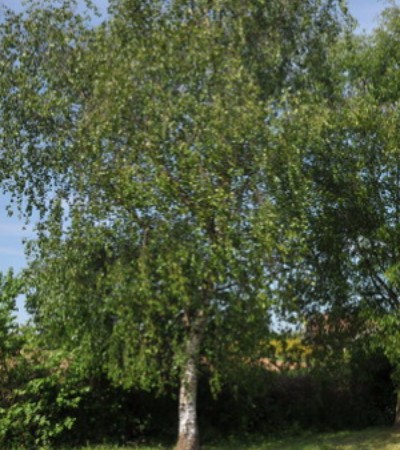Identifying a Birch Tree
A mature tree usually has an open and airy canopy with big branches that droop downwards. The bark is white to grey in colour and sheds thin layers of skin-like bark; this is darker grey underneath and has a rough base. Once matured, the bark becomes less smooth and it develops diamond shaped scores. The twigs have tiny warts on them and are smooth to touch. Leaves are light green and oval in shape with serrated edges; these turn to yellow in autumn before falling.
Silver birch trees are monoecious which means that male and female flowers (catkins) are contained within the same tree during April and May. The long male catkins are brown to yellow in colour and appear in bunches of two to four directly at the tip of new shoots. The bright green female catkins are short, small and erected. Once the female flowers are pollinated by wind, they turn to a darker colour. Hundreds of minuscule seeds are made in autumn and are later dispersed by the wind.
Interesting fact: because the roots of the silver birch grow far below the ground, they can get to otherwise inaccessible nutrients deep below the soil, which can help to recondition surface layers of soil through the shedding of its leaves.
Significance to Wildlife
Since the birch has an open canopy (either downy or silver birch) it allows lots of things to grow beneath it such as mosses, grasses, bluebells, violets, wood sorrel and wood anemone.
The tree provides food and shelter for more than 250 species of insect so it naturally supports aphids along with numerous predators such as lady birds and higher up the food chain. Caterpillars from many moths eat the foliage including the pebble hook-tip, angle-shades, Kentish glory and the buff tip. Lots of different fungi also grows on the tree base and beneath the woodland floor including birch brittlegill, fly agaric, birch milk cap, birch knight woolley milk cap and chanterelle.
Hole-nesting birds such as woodpeckers in habit the tree trunks and the seeds are eaten by greenfinches, siskins and redpolls birds.
Myths and Legends
In ancient times, Celtic people used to believe the tree was associated with regeneration and purification. They used to use the twigs to ward off spirits of the old year; gardeners still use them today to purify their gardens.
How We Use Birch
Because birch wood is strong and durable it is well suited for making furniture and handles. It was used in the cotton industry for centuries to make spools, reels and bobbins in Lancashire. The bark was also used for leather tanning.
Today there is little commercial usage because the tree does not grow that large in England compared to other parts of Europe.
Threats, Pests and Diseases
Nursed or planted trees seem to suffer the worst and can be prone to birch dieback caused by fungal diseases such as Anisogramma virgultorum and Marssonina betulae. Trees grow from seed (naturally grown) appear to have more resistance to these kinds of diseases.
If you are happy with this article, please share with your friends. It was brought to you by GraftinGardeners, an arboricultural company specialising in tree surgery. We provide tree removal, tree pruning and stump grinding for customers in Clapham, SW4 and far beyond.






